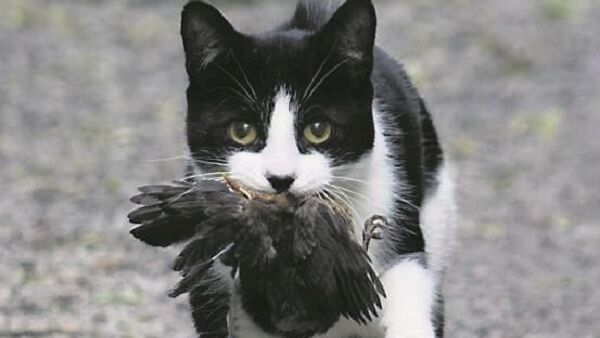Richard Collins: Domestic cats are one of the deadliest predators


Town parks and gardens, the untidier the better, are wildlife havens. Foxes hedgehogs badgers birds and creepy-crawlies have fled to the suburbs from an increasingly inhospitable countryside.
Our gardens serve them well but the benefits come at a price. Chief among the threats to wild creatures is the domestic cat. It kills countless birds.
There may be up to 700,000 cats in Ireland. Most of them roam freely day and night. Their owners want them to hunt mice and rats but not birds. So how destructive are our feline pets?
Assessing the impact of cats on wildlife is notoriously difficult. Some cats bring home the bodies of their victims, displaying them to their owners.
Early estimates of the numbers they killed were based on counts of these. But some cats don’t bring bodies home, nor is it certain that cats that do so display all of their victims.
In 2012, researchers at the University of Georgia fitted ‘kitty-cams’, with LED lights, to 60 cats. The footage they recorded showed that about 50% of the cats never caught anything.
Those that did hunt brought home just one in five of their victims. The predation rate, overall, was about 2.1 victims per cat per week, many of them birds. This suggests that domestic cats may kill up to 400m birds a year in the US. If the Irish situation were comparable, the annual total here would be about 4m.
However, the number of victims per cat is not the whole story. In a paper just published in Animal Conservation, Roland Kays and colleagues from North Carolina State University argue that estimates of the impact on wildlife must take account of the cat numbers in an area and the ranges over which they hunt.
Kays’ team used GPS technology to monitor the movements of 925 pet cats in the US, Britain, Australia, and New Zealand. Citizen scientists tracked the cats and logged the numbers of their bird and mammal victims.

The results showed that most pet cats remained within a 100m radius of their homes. Only three cats ranged over areas larger than 1km².
In a typical suburban environment, a cat will hunt in its owner’s garden and in the immediate vicinity. Around three quarters of the cats hunted primarily in ‘disturbed habitats’.
You might expect that pampered house cats, ‘fed and found’ at home, would kill fewer birds and mammals than wild predators who must survive on what they can catch.
However, a domestic cat, the research indicated, despatches an average of up to 3.5 victims per month, between 14 and 39 victims per hectare per year.
This kill rate is similar to that of similar-sized wild predators. But this should not lead to complacency; the extent of cat predation on suburban wildlife is greater. This is because cats live at much higher densities than wild carnivores.
“As a result, pet cats around the world have an ecological impact greater than native predators but concentrated within a 100m of their homes,” says Kays.
They have “a two to ten times larger impact on wildlife than wild predators, a striking effect”.
- R Kays et al. The small home ranges and large local ecological impacts of pet cats. Animal Conservation. 2020.










